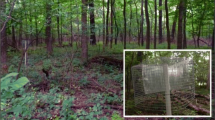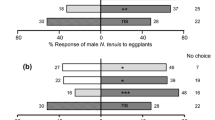Abstract
Large immature and mature female bolas spiders of the genus Mastophora attract certain male moths by aggressive chemical mimicry of those moth species' sex pheromones. These older spiders capture moths by swinging a “bolas” (i.e., a sticky globule suspended on a thread) at the approaching male moths. Juvenile bolas spiders do not use a bolas, but instead use their first two pairs of legs to grab prey, which our field observations suggested were primarily nematocerous Diptera. Our field experiments over a 2-year period demonstrated that juvenile bolas spiders attract moth flies (Psychodidae), with each species apparently specializing on a particular prey species. In three experiments, sticky traps containing young Mastophora phrynosoma spiderlings consistently captured significantly more male Psychoda phalaenoides than were captured on traps containing spiderlings of other Mastophora species or no spiderlings (control traps). Results from two of the three experiments suggested that Mastophora hutchinsoni spiderlings attract male Psychoda trinodulosa. Only two of our experiments included Mastophora bisaccata and those produced contrasting results. In the first experiment, M. bisaccata appeared to attract P. phalaenoides, albeit in lower numbers than were captured on traps containing M. phrynosoma. However, in a second experiment the following year, M. bisaccata spiderlings attracted Psychoda satchelli, a species that had not been caught on any traps the previous year. As suggested by a systematist four decades ago, the taxon currently called M. bisaccata may consist of two or more sibling species, which could account for the contrasting results obtained from our two experiments involving M. bisaccata. This is the first reported evidence that, during early developmental stadia before these spiders attract moths, juvenile bolas spiders attract their prey.
Similar content being viewed by others
References
Akerman C (1923) A comparison of the habits of a South African spider, Cladomelea, with those of an Australian Dicrostichus. Ann Natal Mus 5: 83–88
Davies VT (1988) An illustrated guide to the genera of orb-weaving spiders in Australia. Mem Queensland Mus 25: 273–332
Eberhard WG (1977) Aggressive chemical mimicry by a bolas spider. Science 198: 1173–1175
Eberhard WG (1980) The natural history and behavior of the bolas spider Mastophora dizzydeani sp. n. (Araneidae). Psyche 87: 143–169
Eberhard WG (1981) The single line web of Phoroncidia studo Levi (Araneae: Theridiidae): a prey attractant? J Arachnol 9: 229–232
Gertsch WJ (1955) The North American bolas spiders of the genera Mastophora and Agatostichus. Bull Am Mus Nat Hist 106: 221–254
Hamilton JGC, Dougherty MJ, Ward RD (1994) Sex pheromone activity in a single component of tergal gland extract of Lutzomyia longipalpis (Diptera: Psychodidae) from Jacobina, northeastern Brazil. J Chem Ecol 20: 141–151
Haynes KF, Yeargan KV, Millar JG, Chastain BB (1995) Identification of the sex pheromone of Tetanolina mynesalis (Lepidoptera: Noctuidae), a prey species of the bolas spider, Mastophora hutchinsoni. J Chem Ecol (in press)
Hutchinson CE (1903) A bolas throwing spider. Sci Am 89(10): 172
Longman HA (1922) The magnificent spider: Dicrostichus magnificus. Notes on cocoon spinning and method of catching prey. Proc R Soc Queensland 33: 91–98
Newman JA, Elgar MA (1991) Sexual cannibalism in orb-weaving spiders: an economic model. Am Nat 138: 1372–1395
Quate LW (1955) A revision of the Psychodidae (Diptera) in America north of Mexico. Univ Calif Publ Entomol 10: 103–273
Quate LW (1960) Psychodidae. Part VI, seventh fascicle, guide to the insects of Connecticut. Connecticut State Geol Nat Hist Survey Bull 92: 1–54
Redborg KE, Hinesly TD, Ziegler EL (1983) Rearing Psychoda alternata (Diptera: Psychodidae) in the laboratory on digested sewage sludge, with some observations on its biology. Environ Entomol 12: 412–415
Stowe MK (1986) Prey specialization in the Araneidae. In: Shear WA (ed) Spiders: webs, behavior, and evolution. Stanford University Press, Palo Alto, Calif, pp 101–131
Stowe MK, Tumlinson JH, Heath RR (1987) Chemical mimicry: bolas spiders emit components of moth prey species sex pheromones. Science 236: 964–967
Ward RD, Hamilton JGC, Dougherty M, Falcao AL, Perez JE, Veltkamp CJ (1993) Pheromone disseminating structures in tergites of male phlebotomines (Diptera: Psychodidae). Bull Entomol Res 83: 437–445
Yeargan KV (1988) Ecology of a bolas spider, Mastophora hutchinsoni: phenology, hunting tactics, and evidence for aggressive chemical mimicry. Oecologia 74: 524–530
Yeargan KV (1994) Biology of bolas spiders. Annu Rev Entomol 39:81–99
Author information
Authors and Affiliations
Corresponding author
Rights and permissions
About this article
Cite this article
Yeargan, K.V., Quate, L.W. Juvenile bolas spiders attract psychodid flies. Oecologia 106, 266–271 (1996). https://doi.org/10.1007/BF00328607
Received:
Accepted:
Issue Date:
DOI: https://doi.org/10.1007/BF00328607




